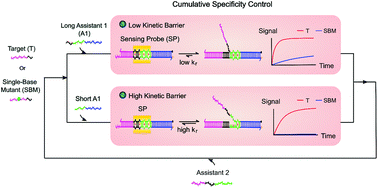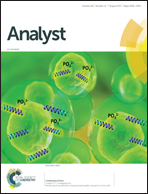Kinetically modulated specificity against single-base mutants in nucleic acid recycling circuitry using the destabilization motif†
Abstract
Signal amplification in nucleic acid sensing improves detection sensitivity, but difficulties remain in sustaining specificity over time, particularly under excess amounts of single-base mutants. Here, we report simple, self-refining target recycling circuitry, which cumulates differentiation between on and off targets by 2-step cyclic interaction with the sensing probe. In the reaction, the analyte recycles only if the protective strand of the sensing probe is removed. The dissociation kinetics of such interaction was modulated by reacting it with different lengths of assistant strands. When shorter assistant strands are used, the destabilization motif of the sensing probe has to spontaneously dissociate before another assistant strand approaches and fully displaces it. This sets up a high kinetic barrier sensitive to the subtle reaction energy differences imposed by the single-base mutants, and substantially improved specificity. As a proof of concept, a microRNA 21 DNA analogue was chosen as our target analyte together with its 14 point mutants (substitution, insertion, or deletion) for specificity measurements. The experimental results corroborate that our system amplifies signals in a comparable manner to the traditional one-layer recycling approach but with negligible system leakage. With the use of shortened assistant strands, up to 100 fold increase in the discrimination factor against the single-base mutants is observed. Specificity is sustainable or even increased over long period measurements (i.e. 4 days). More importantly, target differentiation is successfully demonstrated even in excess amounts of spurious analogs (100×) and low target frequency mixtures (i.e. 0.1%), which mimic the lean conditions practically encountered. Explicit mechanisms of the system specificity are elucidated through analytical calculations and free energy level diagrams. The modularity of the destabilization motif herein promises detection of different nucleic acid based targets and integration into other signal amplification approaches for specificity enhancement.



 Please wait while we load your content...
Please wait while we load your content...